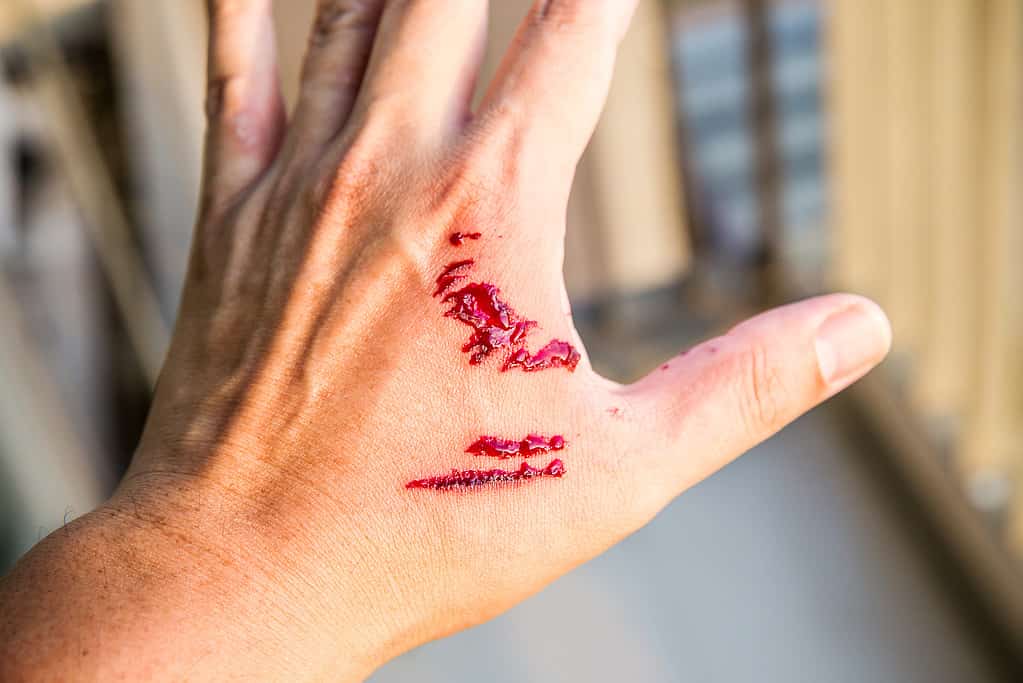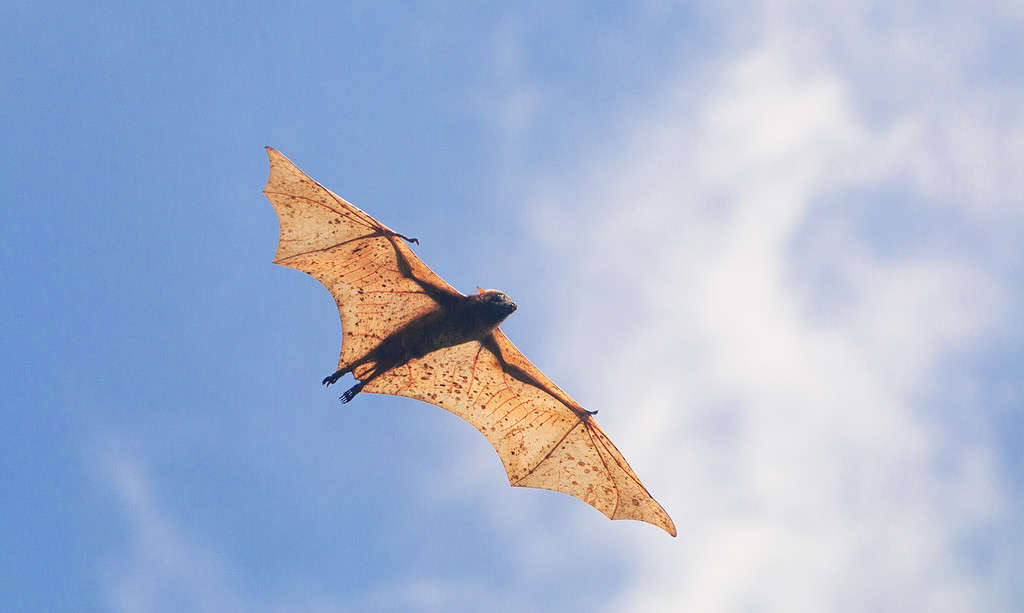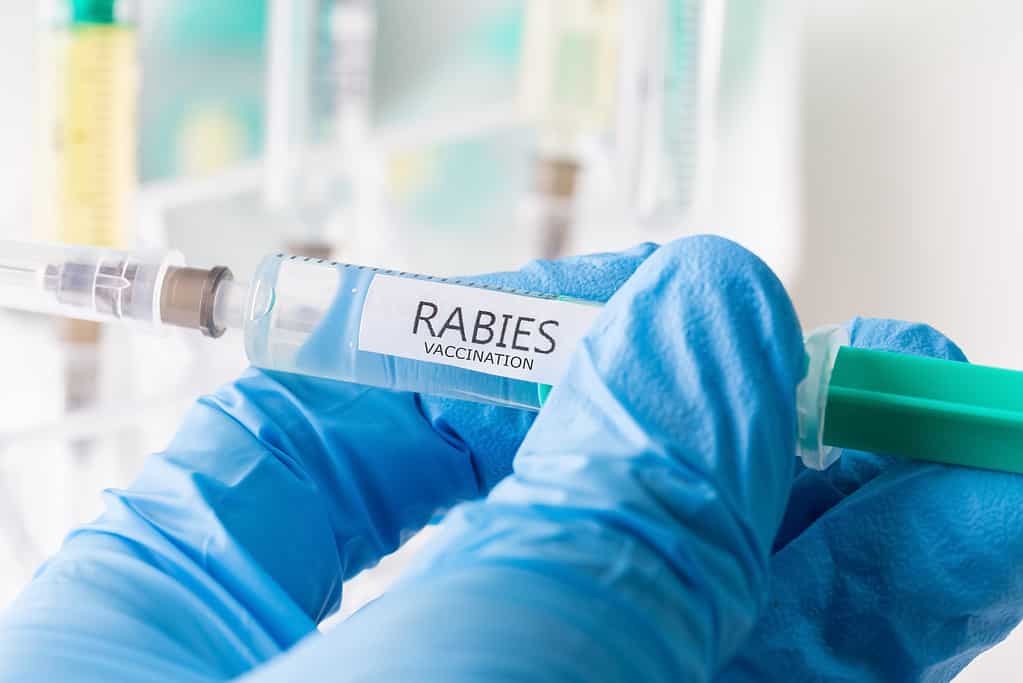Let’s talk about rabies. It’s not a very fun topic, especially if you’ve just been bitten by a wild animal and you don’t know if you’re at risk of contracting the disease. The Centers for Disease Control describes rabies as a preventable viral disease that is most often transmitted through the bite of a rabid animal. Even the thought of the risk of contracting this virus is scary, and sometimes we don’t know what level of risk we’re facing. Today, we’ll be looking at risk factors associated with squirrels. Squirrels are a common part of life across the globe, and especially in North America. In many areas, it is hard to go a day without seeing a squirrel. Can squirrels have rabies? Can squirrels transmit rabies to humans through bites?
First, we have to explore the actual virus a little more. We’re going to take a look at what rabies is, who it impacts, and what it does to the body. Then, we’ll investigate the risk factors associated with squirrels and rabies. We’ll take you through what to do if you’ve been bitten by a squirrel. Finally, we’ll explore rabies risk factors – what animals are most likely to transmit the virus, where the virus is most likely to occur, and what to do to avoid getting it. Let’s begin!
What Is Rabies?

This is a 3D illustration of the rabies virus at its cellular level.
©EzumeImages/iStock via Getty Images
Rabies is a viral disease that targets the central nervous systems of mammals. This eventually leads to brain disease and death. Any mammal can get rabies, though some mammals experience a significantly higher risk. Rabies is in the virus order Mononegavirales. It is in the Rhabdoviridae family of this order, which is a group of viruses with a distinct “bullet” shape. In this family, the genus Lyssavirus contains rabies, along with several other viruses.
Rabies is a zoonotic virus. That means it is a virus that is transferred from animals to humans. Human-to-human transmission is rare and has only been documented in instances of infected organ and tissue donation.
There are two forms of rabies – furious rabies and paralytic rabies. Death from furious rabies usually occurs a few days after the onset of clinical symptoms by way of cardiorespiratory arrest. Death from paralytic rabies takes much longer. This version of rabies slowly paralyzes the muscles until the victim slips into a coma and eventually dies. Paralytic rabies, according to the World Health Organization, accounts for about 20 percent of human cases of rabies, though they also state that this number is impacted by misdiagnoses that can lead to underreporting.
How Is Rabies Spread?
Rabies is transmitted only through direct contact. What does this mean? A human must share tissue or fluids with an infected animal to get rabies. The most common form of transmission is through a bite from a rabid animal, but it is also possible to contract rabies from scratches. Also rare but possible is open contact with infected material from an infected animal – such as getting infected saliva in mucus membranes or open wounds.
There is no associated risk of infection from a rabid person to another person. So, for example, if your friend has contracted rabies, casual contact with them shouldn’t be an issue. Theoretically, it is possible to contract rabies from a rabid human, but no such instances have ever been recorded.
Symptoms of Rabies

Fevers are just one of the many symptoms of clinical rabies. A fever may be the first symptom someone experiences when they contract the virus.
©Ridofranz/iStock via Getty Images
It’s important to know that a reaction to a bite from a rabid animal will be delayed. The rabies virus must travel all the way to the brain and incubate before it can cause notable symptoms. This incubation period can last for weeks or even months and varies based on the type of rabies, existing immunity in the system, and the location of the exposure. Specifically, the average incubation for rabies is two to three months, but can vary from as little as one week to as much as one year.
We’ve compiled a list of symptoms of rabies, starting with the first and mildest symptoms and progressing onward to the most serious.
- weakness or discomfort
- fever
- headache
- prickling or itching at site of the bite
- cerebral dysfunction
- anxiety
- confusion and agitation
- abnormal or excitable behavior
- lack of coordination
- loss of appetite
- hyperactivity
- delirium
- hallucinations
- aerophobia (fear of drafts or fresh air)
- hydrophobia (a fear of water)
- paralysis
- insomnia
- coma
- death
We’d like to note that these are not the only symptoms related to rabies and that there are other potential signs and symptoms of rabies. It is also important to note that rabies in nearly always fatal once clinical symptoms appear. The CDC states that less than 20 humans have been documented to have survived clinical rabies. However, catching rabies before clinic symptoms arise has a good level of success, and this begins at the time of the bite. Now that we know more about rabies, let’s look at squirrels and their relationship with rabies.
Can Squirrels Have Rabies?

Squirrels have never been recorded as spreading rabies to other animals or humans.
©Saeedatun/Shutterstock.com
Squirrels, in fact, are not a risk factor for rabies. This is also true of most other small rodents, such as hamsters, guinea pigs, rats, and mice. Also, most wild rabbits don’t carry or transmit rabies. This doesn’t mean they cannot have rabies. It just means that the rate of infection is low to none and there are no cases of squirrels transmitting rabies to humans. Let’s refer to a study performed from 1995-2010 about this specific topic.
“Rabies in rodents and lagomorphs in the United States, 1995-2010” is a study performed over a series of years by a number of experts and professionals. This study specifically observes rodents and lagomorphs that were submitted to state labs for rabies diagnosis during the times mentioned above. This was inclusive of 737 rabid animals, which accounts for only one percent of the total number of animals submitted for rabies testing. Of these 737 animals, only nine (1.2 percent) were rabid squirrels. 90 percent (663 animals) of the rabid mammals submitted were groundhogs. Beavers and European rabbits made up the next high-risk category.
The study concluded, then, that groundhogs carried the highest risk of rabies virus and transmission, while only nine squirrels over 15 years in this study tested positive for rabies. It’s also good to note that, because of how common they are, squirrels were the most commonly submitted rodent for rabies testing. Of the 70,682 animals submitted for rabies testing over this 15-year period, squirrels made up 31.1 percent of them (21,977 squirrels). Conclusively, 0.04 percent of submitted squirrels were actually rabid.
Can squirrels have rabies? Yes. Do they often have rabies? No, actually, almost never.
How to Treat a Squirrel Bite

Make sure to properly tend your bite wound to avoid infection.
©kckate16/iStock via Getty Images
While there are no cases of squirrels transmitting rabies to humans, it is still important to get proper treatment for a squirrel bite. For this section, we have referred to the Mayo Clinic for the best advice for an animal bite. For a small animal bite or scratch, the first thing you want to do is appraise the wound. Has the skin been broken? How deep is the wound? If the wound is minor, like a small cut or scrape or a shallow bite, proceed with these steps.
First, wash the wound thoroughly with soap and water. Start by washing with cold water and then follow with warm water. Make sure the entire area is well-cleaned before drying. Dry the wound with clean or sterile material or allow it to air dry. Next, apply an antibiotic cream or ointment and then cover the bite or scratch with a clean bandage. If you notice any sudden changes in health or around the bite, contact your medical professional immediately.
If you are unsure of the severity of the bite, contact your provider immediately. Deep punctures and large lacerations need to be treated by a medical professional. Are you bleeding significantly? Is your skin badly torn? Is there a lot of swelling, redness, pain, or oozing around the wound at the time of the bite or in the days following? Did you notice the squirrel exhibiting strange or unusual behavior prior to the bite? Prompt medical care is the best route if you have answered yes to any of these questions. Take extra care in order to avoid the potential for a viral or bacterial infection. Rest assured, though, that your risk of contracting rabies from a squirrel is very low.
What Animals Carry Rabies?

Bats are the main rabies reservoirs in the United States.
An animal that carries a high risk of transmitting rabies is known as a “reservoir”. These animals are also called rabies vectors. Rabies only affects mammals, particularly ones with warmer body temperatures. Birds, fish, and snakes are not mammals, so they cannot catch or transmit rabies. In the United States, the most common rabies vectors are bats and raccoons. Worldwide, dogs make up 99 percent of rabies transmissions to humans. This may seem high, but consider this. In the United States, there are only one to three reported cases of rabies annually. Dogs in the United States are required to have rabies vaccinations from a very young age and are at a much lower risk of catching and transmitting the virus. Because of this, most or all of the rabies cases in the United States are from wild animals.
However, the United States does not share the same culture with the world. Many countries struggle with maintaining populations of wild, stray, and feral packs of dogs. Many – or even most – of these dogs are not vaccinated against rabies and are not socialized to humans. Let’s look at rabies vectors in the United States in a list format. The CDC says that contact with infected bats is the absolute leading cause of rabies in the United States, with statistics at 7 out of 10 Americans who die from rabies in the United States having contracted it from bats. Here is a list of the top four rabies vectors in the United States.
- Bats
- Raccoons
- Skunks
- Foxes
How to Prevent Rabies

Vaccination against rabies is one of the first lines of defense against the virus.
©Teka77/iStock via Getty Images
First and foremost, we would like to remind you to not be too alarmed about rabies if you live in the United States. As we said before, there are only between one and three cases a year of rabies. This is due to all of the incredible preventative measures we already take when it comes to the virus. The first thing you should always remember is to keep a safe distance from wild animals. Not only do they need their natural habitats undisturbed in order to survive, but they can also carry a risk to you. We must protect and preserve nature by, for the most part, leaving it alone. Do not approach animals in the wild – even if they’re injured – unless you are an expert and have the proper resources.
Next, make sure all of your domestic pets get their rabies vaccinations. It’s imperative to note that pets and livestock have only gotten rabies in situations where the animals did not receive vaccinations or the vaccinations were not up to date. Rabies vaccinations are incredibly effective in preventing the virus.
Finally, take the right steps if you sustain a bite that you suspect came from a rabid animal. Always check with a medical professional if you have come into close contact with a bat. Situations where a bite is in question are treated with post-exposure prophylaxis (PEP). This treatment is a dose of human rabies immune globulin (HRIG) and a rabies vaccine. These treatments are given on the day of exposure and then on days 3, 7, and 14 following the exposure. If you have been previously vaccinated for rabies, you only need the one vaccine. You may also receive a tetanus shot.
How Effective is Rabies PEP?
Rabies PEP is highly effective, with an over 99 percent survival rate. Washing the wound thoroughly and immediately getting PEP practically ensures survival. Every year in the United States, between 30,000 and 60,000 people have to get rabies PEP. This preventative measure is a primary reason for the low rate of rabies virus in humans in the United States.
PEP in combination with regular vaccination of pets and livestock reduces the risk of contracting rabies in the United States to nearly zero. In the first place, getting bitten by an infected animal only carries an up to 15 percent risk of rabies infection, so doing your due diligence and getting proper treatment immediately can reduce your risk of contracting the virus to zero – even if you were definitely exposed.
How Many People Die From Rabies Every Year?
As we stated previously, only between one and three people in the United States die of rabies every year. Worldwide, however, the numbers are a bit more dire. Statistics from the CDC estimate that approximately 59,000 people die from rabies worldwide every year. The United States is very fortunate to have such immediate access to rabies prevention. Our love of our domestic animals is a big contributor to that trend, as well. Other countries with worse public health resources and preventative measures are still struggling with rabies occurrences.
The primary concentration of rabies infections in humans happens in India. This country alone accounts for around 35 percent of rabies deaths in the world.
Summary

Try to avoid feeding wildlife, no matter how cute it is. Even though squirrels don’t carry a risk of rabies, it’s still not good to socialize them to humans. They’re wild animals and should stay wild!
©Benoit Daoust/Shutterstock.com
Squirrels carry little to no risk of having, carrying, or spreading rabies. Most squirrel bites can be treated at home. Still, it is important to administer the proper treatment for a squirrel bite and be aware of the potential risks associated with the injury. Remember to keep a safe distance from animals and check with your health care provider if you have any questions, concerns, or symptoms you are worried about.
Thank you for reading! Have some feedback for us? Contact the AZ Animals editorial team.








